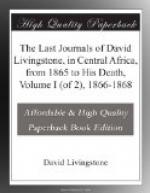[6] Dr. Livingstone was anxious to try camels and Indian buffaloes in a tsetse country to see the effect upon them.
[7] This refers to an attack made upon the boats of the Pioneer when the Doctor was exploring the River Rovuma in 1861.
[8] A species of hemp.
CHAPTER II.
Effect of Pioneer’s former visit. The poodle Chitane. Result of tsetse bites. Death of camels and buffaloes. Disaffection of followers. Disputed right of ferry. Mazitu raids. An old friend. Severe privations. The River Loendi. Sepoys mutiny. Dr. Roscher. Desolation. Tattooing. Ornamental teeth. Singular custom. Death of the Nassick boy, Richard. A sad reminiscence.
1st May, 1866.—We now came along through a country comparatively free of wood, and we could move on without perpetual cutting and clearing. It is beautiful to get a good glimpse out on the surrounding scenery, though it still seems nearly all covered with great masses of umbrageous foliage, mostly of a dark green colour, for nearly all of the individual trees possess dark glossy leaves like laurel. We passed a gigantic specimen of the Kumbe, or gum-copal tree. Kumba means to dig. Changkumbe, or things dug, is the name of the gum; the Arabs call it “sandaruse.” Did the people give the name Kumbe to the tree after the value of the gum became known to them? The Malole, from the fine grained wood of which all the bows are made, had shed its fruit on the ground; it looks inviting to the eye—an oblong peach-looking thing, with a number of seeds inside, but it is eaten by maggots only.
When we came to Ntande’s village, we found it enclosed in a strong stockade, from a fear of attack by Mabiha, who come across the river and steal their women when going to draw water: this is for the Ibo market. They offered to pull down their stockade and let us in if we would remain over-night, but we declined. Before reaching Ntande we passed the ruins of two villages; the owners were the attacking party when we ascended the Rovuma in 1862. I have still the old sail, with four bullet-holes through it, made by the shots which they fired after we had given cloth and got assurances of friendship. The father and son of this village were the two men seen by the second boat preparing to shoot; the fire of her crew struck the father on the chin and the son on the head. It may have been for the best that the English are thus known as people who can hit hard when unjustly attacked, as we on this occasion most certainly were: never was a murderous assault more unjustly made or less provoked. They had left their villages and gone up over the highlands away from the river to their ambush whilst their women came to look at us.




